Surface Spectroscopy of
Nano and Subnano Structures
by
R. Bruch, N. Afanasyeva, P. Kano, D. Schneider*
Department of Physics, University of Nevada, Reno, Reno, Nevada 89503
*Lawrence Livermore National Laboratory, P.O. Box 808, Livermore, California 94550
|
This is a draft paper
for a talk at the
Fifth
Foresight Conference on Molecular Nanotechnology.
The final version has been submitted
for publication in the special Conference issue of Nanotechnology.
Abstract
In light of recent progress in the fabrication and diagnostics of nanostructures and surfaces, more advanced spectroscopic and imaging methods are necessary in order to elucidate the detailed structure, nature, and creation of such microsystems. We present here one especially promising method, namely highly charged ion surface interaction using an Electron Beam Ion Trap (EBIT) facility. Specifically we focus on the microspectroscopy, nano and subnano structure modification of surfaces and generation of x-rays involving heavy highly charged ion/structure interaction. In this process a large amount of potential energy is deposited by single ions at the surface leading to localized surface defects of subnano size. In particular, we present new results on highly charged Biq+ (q=50 to 71) ions interacting with gold surfaces. A detailed experimental and theoretical analysis is provided for the x-ray spectra from the gold surface. These data have been measured at the Lawrence Livermore National Laboratory (LLNL) Electron Beam Ion Trap (EBIT) highly charged ion facility. The comparison of our computer simulation with experimental x-ray spectra provides evidence for the formation of sub-surface hollow atoms. A striking orbital (n) and angular momentum (1) dependence for hollow atoms formation has been found shedding more light on the dynamics of complex ion-surface and ion-solid interaction processes. Finally, new developments in imaging on nano and angstrom scale using heavy highly charged ions are discussed.
Introduction
Ions of extremely high charge state can unlock a large class of new
phenomena in various areas of atomic, plasma, nuclear, and chemical
physics. Examples for research of these topics include ultra high precision
spectroscopy of the atomic structures of such ions, electron-ion
excitation, and recombination cross sections and interactions between high
charged state ions with atoms, molecules and surfaces. The latter present
enormous potential for unprecedented advances in applied physics and
technology, particularly with respect to nano and subnano size technology
involving surface modifications, analysis, imaging and lithography issues.
Furthermore, there are promising opportunities in biophysics applications,
DNA mass spectrometry, and ion source developments. At present, much
effort, including some of our own, is directed toward research on
ion-surface interactions using very highly charged ions (Schneider and Briere 1996, Schneider 1995).
In our research, we have utilized the recently developed technique (Bruch
et al., 1994) of extracting highly charged ions (up to Th80+) from EBIT
for ion-surface interaction studies. The goal of these studies is to
provide an understanding of the neutralization dynamics of very highly
charged ions as they approach the surface and penetrate into a solid. Such
highly charged projectile ions carry up to several hundred keV potential
energy for which x-ray emission studies are particularly suitable
especially with respect to illumination of interaction processes that lead
to the transfer of this potential energy to the surface. The satellite
intensities and energy positions of the emitted x-rays and Auger electrons
provide important information on the history of the projectile ions
interacting with the surface and the bulk material.
The Electron-Beam Ion Trap (EBIT)
A schematic diagram of EBIT, including the ion extraction system, is shown in Fig. 1. A 3 -T axial magnetic field from two superconducting Helmholtz coils compresses an electron beam to current densities of up to 6000 A/cm2 in the drift-tube region. Typical operating electron-beam currents are of the order of I OOmA. The axial magnetic field varies by less then 0.2% over the 2cm length of the ion trap. The drift-tube assembly accelerates the beam electrons to their full interaction energy and provides an axial electrostatic trap for the positive ions. The EBIT is capable of producing electron energies of up to 30 keV. An upgrade of EBIT allows use of electron energies up to 150 keV (Super EBIT). Neutral atoms can be injected through one of the side ports of the trap. In order to inject ions, EBIT is also equipped with a NMVVA (metallic vapor vacuum arc) source that produces initially low-charged ions up to q=+4. Only a fraction of these ions are trapped in the central drift-tube region, where the ions are confined axially by a potential well provided by two end drift tubes. The axial potential-well depth is typically around 100-300 eV. Radial confinement is provided by a combination of the space-charge field of the electron beam and the applied axial magnetic field. The ions undergo successive stages of ionization in the electron beam. The highest ionization stage present in the trap is determined by the electron-beam energy. The number of ions available depends on the ionization, recombination, and charge-exchange cross sections. In order to inject the ions into the trap one must confine them for a given time, ionize them, and then extract them while the potentials on the trap are varied in a fast switching mode. In the extraction phase, the ions are electrostatically deflected and focused through an einzel lens in the path between the MEVVA into the trap. After passing the deflector, the ions are refocused via a second einzel lens and are momentum analyzed in a 90° magnet. A recent example of charge state measurements of extracted uranium ions illustrates the capability of EBIT (see Fig. 2).
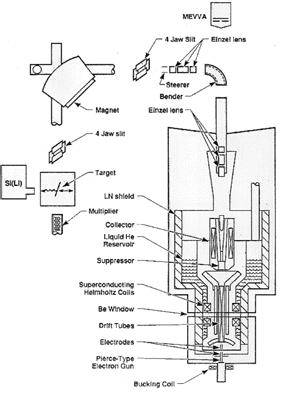
full size version of Fig. 1, 553 x 727 pixels, 52 KBytes
Fig. 1 Schematic of EBIT (Electron Beam Ion Trap) and the ion extraction system. The MEVA (Metal Vapor Vacuum Arc) source injects low charge state ions into the trap. Indicated is also the target chamber for measurements of x-rays and the electrostatic analyzer for electron emission measurement.
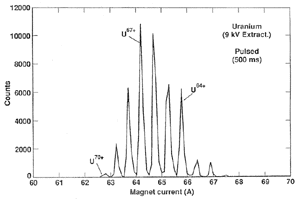
full size version of Fig. 2, 716 x 480 pixels, 29 KBytes
Fig. 2 Charge state distribution of extracted and momentum analyzed uranium ions. The uranium ions were produced with a 9 keV electron beam and confinement times of one second.
Hollow Atom Formation Above and Below Surface
With the development of powerful ion sources such as EBIT, intense beams of ions up to U+92 (a uranium nucleus) can now be created and controlled in the laboratory and used in experiments to probe atomic interactions with surfaces. When a highly charged ion collides with an atom, molecule or solid surface, unusual situations arise in which large numbers of electrons can be captured by an ion approaching the surface. Solid surfaces are particularly interesting because they can effectively supply an infinite number of electrons, and the incident ion can be neutralized above the surface. Following the classical overbarrier model, the neutralization process starts at a critical distance Rc. As illustrated in Fig. 3, highly charged heavy ions are capable of capturing electrons efficiently into high-nl states at relatively large distances above the surface depending on the ionic charge state. Thus, the ion is promoted into a multiply excited state as it approaches the surface with electrons occupying high-nl levels while the core is virtually empty (hollow atoms). The created multiple inner-shell vacancy states provide time windows (atomic clocks) that allow the study of stepwise deexcitation and evaporation of the excitation energy. In these investigations, the following physical processes and parameters are of major importance (Clark et al., 1993):
- The initial electronic configuration of the approaching ion and the surface potential of the solid determine the transfer of electrons from the surface into states with high n quantum numbers.
- The approach velocity and the autoionization and radiative decay rates determine the transfer of electrons to lower states or back to the solid, together with the distribution and time evolution of the population of different quantum states during neutralization.
- Transfer of electrons into states with low quantum numbers occurs when the ion enters into the surface.
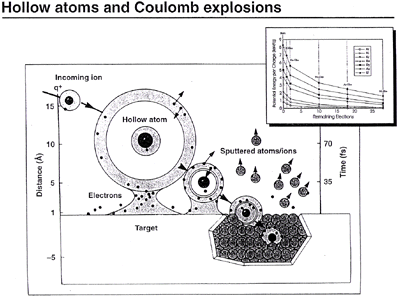
full size version of Fig. 3, 1373 x 1018 pixels, 194 KBytes
Fig. 3 Schematic diagram illustrating the neutralization process of highly charged ions close to a metal surface. The figure shows the creation of highly excited hollow atoms by multiple electron capture. This superexcited state then decays via Auger and radiative cascades. When the hollow atom hits the surface a localized region of surface damage may occur. Also shown in this figure is the creation of a subsurface hollow atom with multiple inner shell vacancies in a sequence of x-ray transitions leading to a bright localized point x-ray source.
As illustrated in Fig. 3, the neutralization process is essentially completed after passage of about IOnm of material within 20fs. In this time frame more than 100 keV of potential energy has been dissipated in the target, leading to the emission of secondary particles (electrons, sputtered atoms and ions) as well as x-ray radiation. Due to the short neutralization time, the corresponding power density incident of an ion can be as large as about 3 x 1019 W/cm3 (Schneider 1995). When a hollow atom strikes a surface, secondary electron and photon emission frequently occurs. In this case, the radius of the projective is larger than the dynamic screening length in the solid,  D = vP / D = vP /  P where P where  P is a surface plasmon frequency and vP the projectile velocity. Therefore, the electrons at higher excited states of the projectile ion are peeled off upon impact. The number of electrons peeled off is of the order of the initial charge state q. Hence, on reaching the surface, many of the loosely bound electrons are lost and others from the solid are captured into lower n states. It is at this stage where the second generation of "subsurface hollow atoms" is formed and subsurface x-ray photon emission and subsurface fast-Auger electron emission processes may occur below a critical principle quantum value. This number can be approximated by n < (q P is a surface plasmon frequency and vP the projectile velocity. Therefore, the electrons at higher excited states of the projectile ion are peeled off upon impact. The number of electrons peeled off is of the order of the initial charge state q. Hence, on reaching the surface, many of the loosely bound electrons are lost and others from the solid are captured into lower n states. It is at this stage where the second generation of "subsurface hollow atoms" is formed and subsurface x-ray photon emission and subsurface fast-Auger electron emission processes may occur below a critical principle quantum value. This number can be approximated by n < (q D)1/2 where D)1/2 where  P = (4 P = (4 ne)1/2 and ne is the concentration of conduction electrons. For Biq+ ions interacting with Au surfaces, we note that above n=7 no discrete ionic states can exist due to dynamical Stark mixing. Based on the above estimates, we assume that the hollow atom is formed near or below n=7 so that the fast subsurface x-ray photon and/or Auger electron emission processes start predominantly in the proximity of n=7 levels of Bi ions. This consistent with our comparison of theoretical data with the experimental spectra in which the most dominant transitions arise from upper n=5 and n=4 levels. Also, our theoretical predictions are in good agreement with the experimental results of the observed x-ray photon emission leading to dominant N and M x-ray structures (Tanaka 1995). ne)1/2 and ne is the concentration of conduction electrons. For Biq+ ions interacting with Au surfaces, we note that above n=7 no discrete ionic states can exist due to dynamical Stark mixing. Based on the above estimates, we assume that the hollow atom is formed near or below n=7 so that the fast subsurface x-ray photon and/or Auger electron emission processes start predominantly in the proximity of n=7 levels of Bi ions. This consistent with our comparison of theoretical data with the experimental spectra in which the most dominant transitions arise from upper n=5 and n=4 levels. Also, our theoretical predictions are in good agreement with the experimental results of the observed x-ray photon emission leading to dominant N and M x-ray structures (Tanaka 1995).
Experimental Results
In our study, bismuth ions with charge states in the range of q=50 to 71 were extracted from the LLNL EBIT and accelerated to energies of qx(7 keV) and subsequently directed to a gold target. The X-ray radiation from the Au target was then observed with a Si(Li) detector. The resulting x-ray spectra for several values of q are presented in Fig. 4 and 5 respectively. In these figures two dominant families of x-rays are observed, i.e. one in the range of 750 to 2000 eV and the other between approximately 2500 and 6000 eV. Both spectral features shift to higher energies with increasing incident ion charge state. The lower energy group, which dominates the spectra for lower incident charge states, arises from the filling of certain vacancies in the N shell while the higher energy group, which predominates for the higher incident charge states, is in the range associated with the filling of M-shell vacancies.
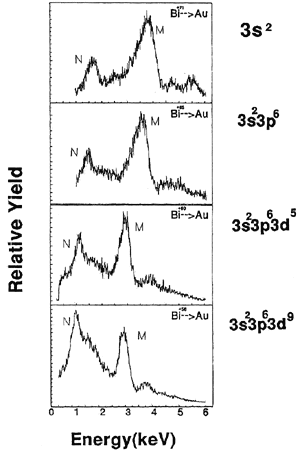
full size version of Fig. 4, 737 x 1110 pixels, 50 KBytes
Fig. 4 Characteristic experimental x-ray spectra of Biq+ (q=71, 65, 60 and 56) ions following interaction with a Au surface. N represents the N x-ray spectra and M the corresponding M x-ray spectra. On the right hand side, the outer shell electronic configurations for each ionic state are provided (Tanaka 1995).
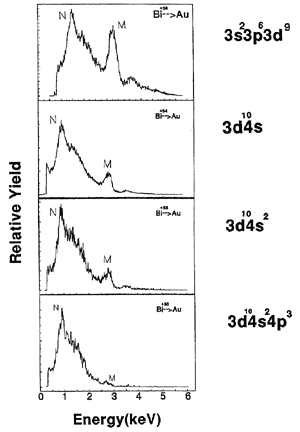
full size version of Fig. 5, 767 x 1104 pixels, 42 KBytes
Fig. 5 Characteristic experimental x-ray spectra of Biq+ (q=56, 54, 53 and 50) ions following interaction with a Au surface. N represents the N x-ray spectra and M the corresponding M x-ray spectra. On the right hand side, the electronic configurations for each incoming projectile ionic state is displayed (Tanaka 1995).
Calculation of Radiative Transition Energies and Transition Probabilities:
Screening Theory
The calculation of radiative transition energies, radiative transition probabilities and autoionizing rates of many electron systems is an important aspect in determining the spectroscopic characteristics of highly charged ions interacting with surfaces. Although, there exist very powerful numerical methods which have been extensively used over the past few years, we have
developed simple efficient analytical approaches, based on screening theory. In this work, we have applied the 1/Z expansion method (Safranova et at. 1993) to predict the peak energies and radiation transition probabilities (Tanaka 1995). These theoretical predictions have been used to identify the most prominent spectral groups for Biq+ --> Au surface collisions and thus the (nl) population during surfaces hollow atom formation. As an example we show a comparison of the predicted energy regions for the 5l' --> 4l and 4l' --> 3l electronic dipole transitions associated with Bi71+, Bi65+, and Bi64+ ions. In this case, 45 initial electronic configurations with multiple inner-shell vacancies have been considered leading to a multitude of different electronic dipole (El) transitions. From the comparison of our theoretical data with the experimental results, it is evident that the initial n population is dominated by n=4 and n=5 principle quantum numbers as indicated in Fig. 6. We have also studied relative line intensities. In particular, we have found that the most dominant transitions of the type 5l' --> 4l stem from 5f --> 4d for the highest charge state, Bi71+ with a significant contribution of 5d --> 4p. On the other hand, 5g --> 4f is the most dominant transition for the lower charges states, such as Bi64+ to Bi50+. For the 41' --> 31 x-ray structures, the most dominant transition observed is 4d-3p for Bi71+ whereas for the lower charge states such as Bi65+ a mixing of 4d --> 3p and 4p --> 3s decays occurs.
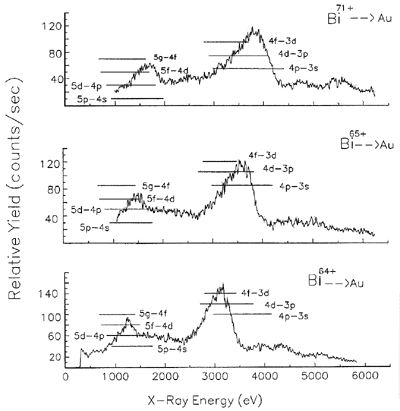
full size version of Fig. 6, 1073 x 1103 pixels, 56 KBytes
Fig. 6 Predicted energy regions obtained from radiative transition energy calculations for the 51'-41 and 41'-31 transitions associated with Bi71+, Bi65+, Bi64+ ions. The experimental spectra are displayed for comparison. The initial and final states arise from many electron systems with varying number of inner shell vacancies and outer shell electrons (Tanaka 1995).
The presence of new dielectronic processes has been observed in the M x-ray spectral region. In this connection, we note that for the incident projectile ions such as Bi55+ to Bi50+ the 3d shell of the incoming ions is completely filled and no M x-rays are expected. Nonetheless, M x-ray line structures have been observed for these ions as clearly indicated in Fig. 5. A possible explanation for this effect is that one electron of the closed 3d shell is excited to a higher unoccupied subshell via a dielectric process, thus creating an inner shell vacancy that can be filled via a radiative transition. The observed x-ray spectra provide important fingerprints for the creation of the subsurface hollow atoms and the deexcitation processes, filling multiple inner shell vacancies during the interaction mechanism. We note that these hollow atoms play also an important role in the interaction of clusters with ultra fast lasers (Marowsky and Rhodes 1996, Borisov et al. 1995) and lead to an enhanced x-ray amplification. This x-ray enhancement is a prerequisite of the development for important new imaging technologies on a nanoscale.
Potential Applications
One possible application of highly charged ions is nano-fabri cation using the large amount of potential energy conveyed by each ion. This energy is deposited at the surface and may lead to localized surface interactions, 'Coulomb displacements', or even 'Coulomb explosion', and can produce nano-size surface-defects by single ions (Parilis et al. 1993, Hughes 1995, Schneider et al. 1993). Another important application of heavy highly charged ions is associated with the generation of intense emission of secondary electrons and x-rays.
Some of the new future imaging applications of the EBIT ion source are shown in Fig. 7. Among these are new imaging methods using secondary electrons and x-rays following single ion impact on a surface with unprecedented resolution in the submicron range. Moreover, secondary ion mass spectrometry (SIMS) on a micro or even nano scale may be possible in the near future. In addition, x-ray microscopy for surface characterization of nano structures and biomolecules could be realized using an EBIT facility. Presently, we are in the process to develop new concepts of x-ray, soft x-ray, and ELJV optical instrumentation for a variety of EBIT applications, including advanced x-ray imaging technologies. These type of imaging methods depend on the spatial scale of resolution obtainable with single ions interacting with surfaces.
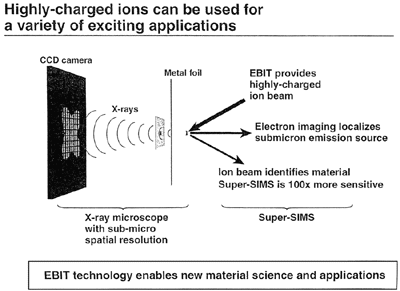
full size version of Fig. 7, 900 x 655 pixels, 66 KBytes
Fig. 7 New Applications of the EBIT technology.
Conclusions
To summarize, we have confirmed that subsurface hollow atoms with multiple core vacancies in the M and N shells are produced efficiently in highly charged Biq+ ions interacting with gold surfaces. We have been able to identify the most prominent transitions in the N and M x-ray regions. Furthermore, we have found that multiple inner shell hole states stabilize predominantly via 51'-41, 61'-41 and 71'-41 radiative transitions (N x-ray region). In addition, the hollow atoms created decay by 51'-31 and 41'-31 transitions (M x-ray region). In order to support the identification of the most dominant peak structures of the N and M x-ray spectra a huge theoretical database has been created. By using our calculated relative line intensities we have been able also to determine the most likely many body states contributing to the enhanced x-ray emission due to optical cascades. Finally, we have been able to account for new dielectronic processes for Bi55+ to Bi50+ projectile ions where strong 4f --> 3d transitions were observed for the first time. Such fundamental x-ray studies are of importance to elucidate the spectral composition and characteristics of short wavelength radiation emitted from highly charged ions. As a subsequent development, we envision to create new optical methods of microspectroscopy and microimaging in the EUV, soft x-ray and x-ray regions using single highly charged ions interacting with surfaces (Kantsyrev 1997).
Acknowledgement
We would like to thank Dr. Tsukiyo Tanaka from LLNL for providing the
theoretical calculations and Professor Ulyana Safranova from the Institute
of Spectroscopy, Russian Academy of Science for introducing us to the many
body screening theory of highly charged ions. Furthermore we would like to
express our gratitude to Arunachalam Yegappan and Ambu Yegappan for
assisting us in the preparation of the manuscript. Finally, we are indebted
to Dr. Dieter Schneider from the EBIT facility at LLNL for his continued
support and for providing us with the Biq+, --> Au data.
References
1. Schneider D.H.G. and Briere M.A. (1996) Physica Scripta, 53, pages 228-242. Investigations of the Interactions of Highest Charge State Ions with Surfaces
2. Schneider D. (1995) Lawrence Livermore National Laboratory, S4. EBIT Electron Beam Ion Trap, Annual Report
3. Bruch R., Rauscher E., Fiffling S., Schneider D., Mannervik S. Larsson M. (1994), Encyclopedia of Applied Physics, Vol. 10, pages 437-470 VCH Publishers, Molecular And Atomic Collision Processes With Ion Beams
4. Clark M.W., Schneider D., Dewitt D., McDonald JW., Bruch R., Saft-anova U.I. Tolstikhina I.Yu., Schuch R. (1993) Phys. Rev. ray emission following Xe44-48+ ion impact on Cu surfaces
5. Tanaka T. (1995) Ph.D. Thesis, University of Nevada Reno, unpublished, Transition Energies and Probabilities of Highly Charged Ions: Applications to Xeq+ and Biq+ Ion-Metal Surface Interactions
6. Safronova U.I., Tolstikhina, Bruch R., Tanaka T., Hao F., D. Schneider (1993) Physica Scripta 47, pages 365-382, Screening Theory for Transition Energies of Highly Charged Ions
7. Parilis E.S., Umarov F.F., Kishinevsky L.M., Verleger V. Kh, Turaev N.Yu., Nizhnaya S.L., Baklitzky B.E., Bitensky I.S. (1993) North Holland, Amsterdam, pages 339-386, 491-545 and 551-605 Atomic Collisions on Solid Surfaces
8. Hughes I. (1995) Physics World April 1995, page 43 Charge of the Hollow Atom
9. Schneider D., Briere M.A., McDonald J., Blersack J. (1993) Radiation Effects and Defects in Solids 127, page 113 Ion Surface Interaction Studies With Highly Charged Ions
10. Schneider D., Briere M.A., Clarke M.W., McDonald J., Biersack J., Siekhaus W. (1993) Surface Science 294, page 403 Atom Displacement due to Electrostatic Potential Energy of Very Highly Charged Ions at Solid Surfaces
11. Marowsky G. and Rhodes C.K. (1996) Physikalische Bldtter 52, pages 991-994 Hohle Atome Und die Kompression von Licht in Plasmakandlen
12. Borisov A.B., McPherson A., Thompson D., Boyer K., Rhodes C.K. (1995) J. Phys. B28, page 2143 Ultrahigh Power Compression for x-ray Amplification- Multi-Photon ClusterExcitation Combined with Nonlinear Channeled Propagation
13. Kantsyrev VL., Bruch R., Phaneuf R., Publicover N.G. (1997), Journal of X-Ray Science And Technology 7, pages 139-158, New Concepts for X-ray, Soft x-ray, and EUV Optical Instrumentation Including Applications in Spectroscopy, Plasma Diagnostics, and Biomedical Microscopy: A Status Report
|